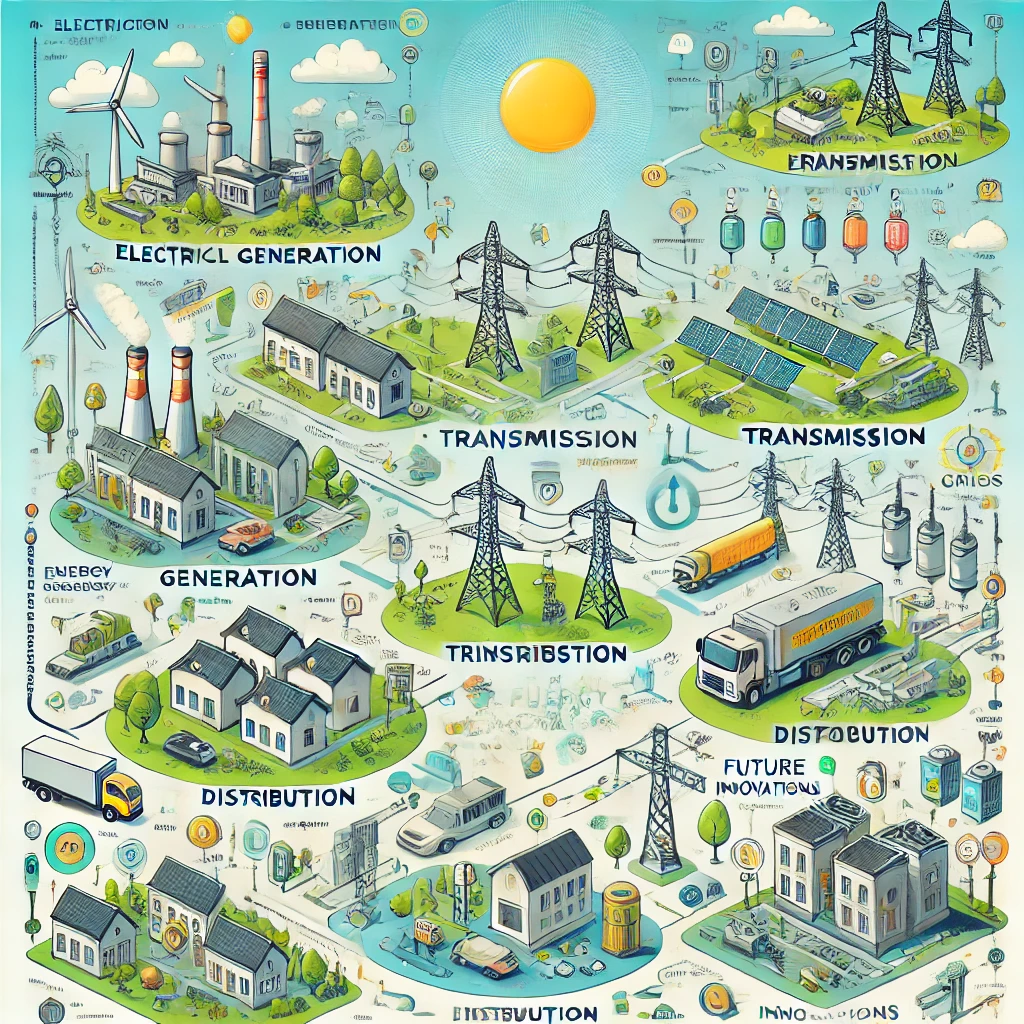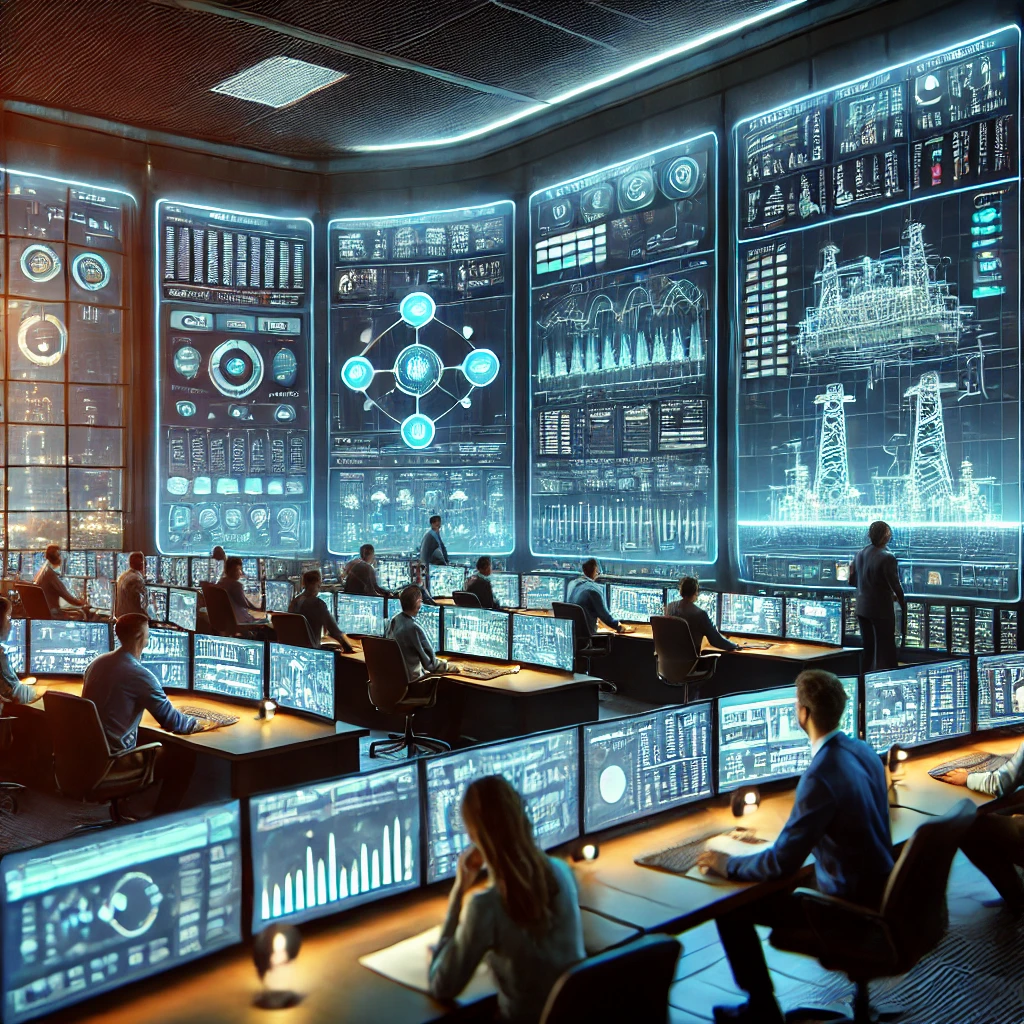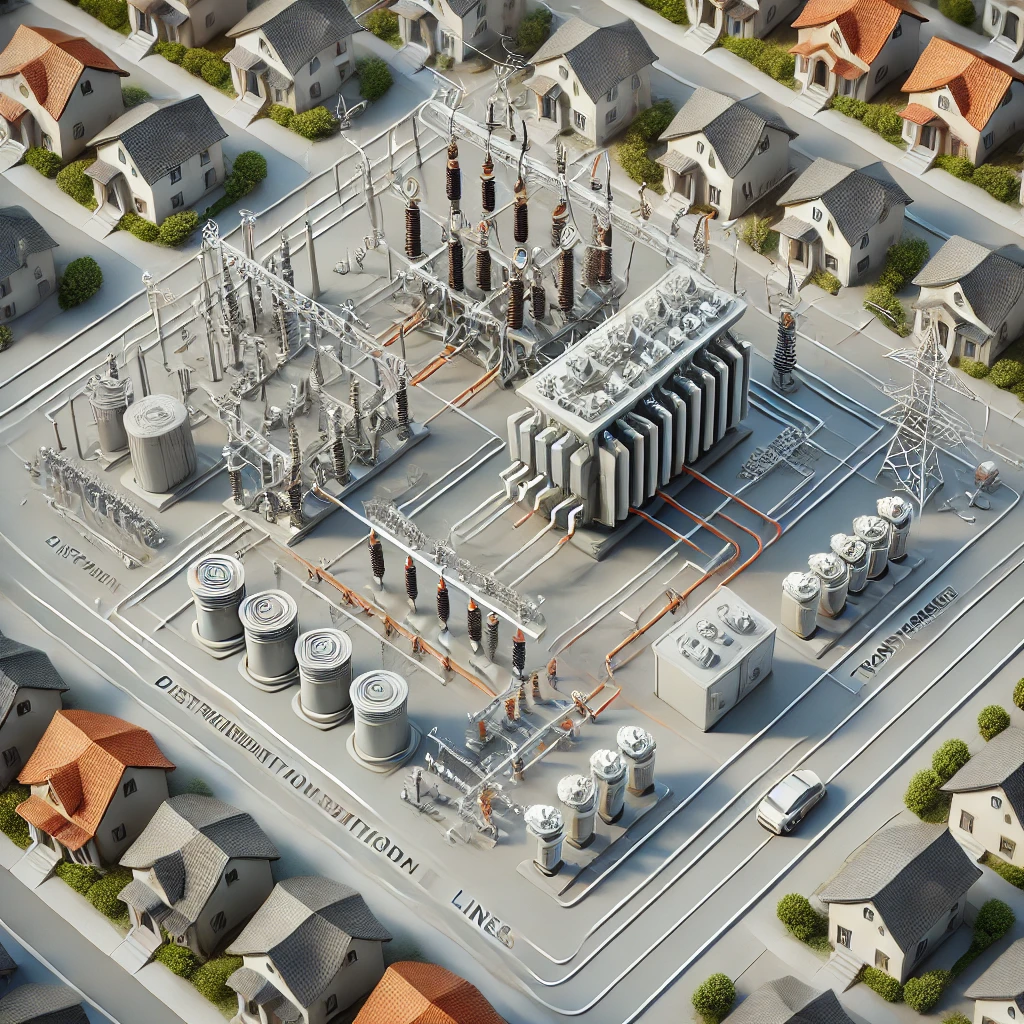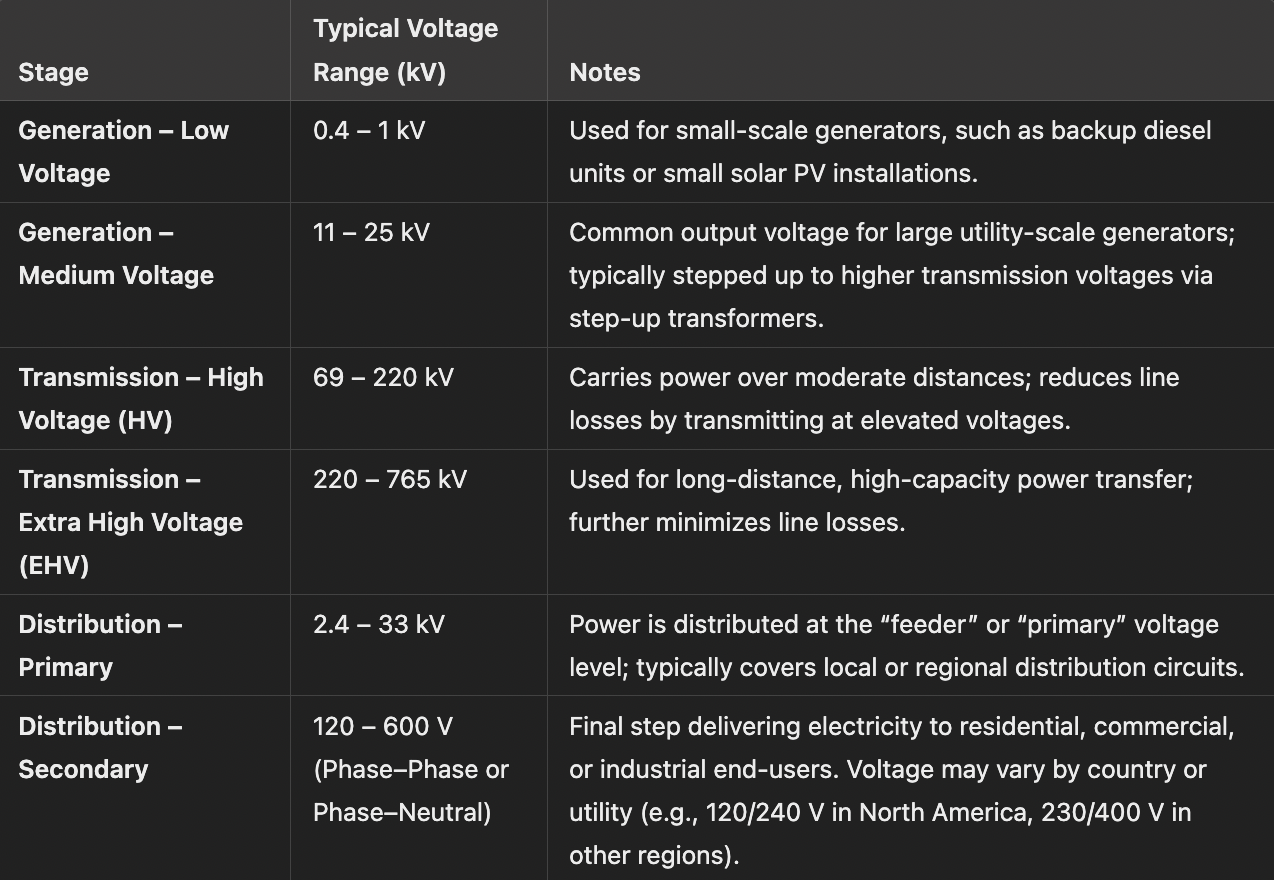An In-Depth Overview of Electrical Generation, Transmission, Distribution, and Future Innovations

High level conceptual picture of Generation, Transmission and Distribution Systems
Electricity powers modern civilization, enabling technological advancements and industrial growth. Its journey from generation to end-users involves intricate systems of infrastructure and management. This whitepaper explores the critical stages of this journey — generation, transmission, and distribution — while examining the transformative potential of Distributed Energy Resources (DERs) and Distributed Energy Resource Management Systems (DERMS).
1. Electrical Generation
Electrical generation involves transforming various energy sources into electricity. It serves as the first step in the power supply chain, supporting global energy needs and driving technological and economic development. In all forms of electricity generation, there has to be a prime mover which makes the turbine rotates using application of water or steam, wind, tides and consequently generator rotates as the turbine and generator are mechanically coupled. Usually, the rotor has DC excitation and due to the electro-magnetic induction the stator develops AC voltage. The stator terminals are usually connected to Power Transformers and the power transformer boosts the voltage levels and feeds into transmission lines. Transmission lines take the power to distribution stations which eventually feeds the loads.
The generation method is different in the case of solar-based generation where static photovoltaic cells absorb solar energy and thereby generate electricity.
Primary Energy Sources
- Fossil Fuels: Fossil fuels, such as coal, natural gas, and oil, remain significant contributors to power generation. Combustion processes produce steam that drives turbines connected to electricity generator. Their abundant supply ensures reliability, but their environmental impact necessitates innovative solutions to reduce emissions.
- Renewable Energy: Renewable sources like solar, wind, hydropower, and geothermal energy provide sustainable alternatives. These resources reduce carbon emissions and are vital for achieving global climate goals. Their intermittent nature, however, requires advanced storage and grid integration strategies.
- Nuclear Energy: Nuclear power harnesses energy from nuclear fission to produce steam, offering high-capacity generation with minimal greenhouse gas emissions. While it promises significant benefits, concerns over safety and waste management persist. In nuclear fission a neutron hits the uranium atom to produce energy. This action generates three more neutrons. Those split neutrons hit another uranium atom and this controlled chain reaction generates heat, which can be used to harness electricity.
Power Generation Methods
- Thermal Power Plants: Convert heat from combustion or nuclear reactions into steam to drive turbines. They dominate global energy production but face challenges related to efficiency and emissions.
- Hydroelectric Power Plants: Use gravitational water flow to rotate turbines. These plants are clean and reliable but depend on geographic suitability. Fast running water is not available in all locations to generate a meaningful amount of electricity. Running water should have a good amount of flow and there must be a way to control the flow (i.e. a reservoir or dam which is at some significant height).
- Wind Farms: Transform kinetic energy from wind into electricity using turbines. They are sustainable and scalable but location-dependent. Wind farms need to be located on open plains, on top of hills, or in mountain passes where wind speed is accelerated.
- Solar Power Plants: Utilize photovoltaic cells or concentrated solar power systems to convert sunlight into electricity. Solar technology continues to advance, reducing costs and improving efficiency.
Challenges in Generation
- Transitioning to cleaner energy sources.
- Enhancing the efficiency of renewable generation technologies.
- Balancing real-time energy demand with variable renewable generation.
2. Electrical Transmission
Transmission systems transport electricity over vast distances from generation sites to distribution networks. High-voltage systems ensure efficiency by minimizing energy losses. High voltage produces low current levels for the same amount of power transfer and thus yields low losses.
Key Components
- Transmission Lines: High-voltage lines enable the transport of electricity across long distances, connecting remote generation facilities to urban demand centers.
- Substations: Act as critical nodes where voltage is stepped up for transmission and stepped down for local distribution, ensuring efficient energy flow.
- Transformers: Modify voltage levels to align with grid requirements and end-user needs, ensuring stability and reliability.
- Control Centers: Monitor and manage grid operations, balancing supply and demand to prevent outages and ensure seamless functionality.

Transmission Control Center
Types of Transmission
- AC Transmission: Alternating Current systems dominate due to their compatibility with transformers and efficient voltage regulation over long distances.
- DC Transmission: High Voltage Direct Current systems are preferred for specific applications, such as underwater cables and long-distance energy transfer, due to lower energy losses. DC power transfer negates the reactive component of line impedance (how much the line itself resists the flow of electricity), so the losses are low in DC transmission but requires a good amount of investment to convert power to DC from AC.
Challenges in Transmission
- Upgrading aging infrastructure to meet modern energy demands.
- Addressing grid congestion caused by increasing energy loads.
- Integrating renewable energy sources with variable outputs into existing transmission systems.
3. Electrical Distribution
Distribution systems deliver electricity from substations to end-users, adapting voltage levels to ensure safety and usability for home appliances, which are safer to operate in low voltage levels. This stage bridges the gap between large-scale transmission networks and individual consumers.
Components
- Distribution Substations: Step down high transmission voltages to levels suitable for local distribution, enabling safe and efficient energy delivery.
- Distribution Lines: Comprise overhead and underground networks that carry electricity to residential, commercial, and industrial areas.
- Transformers: Reduce voltage levels further, ensuring compatibility with household and industrial equipment.
- Meters: Enable precise monitoring of electricity usage, supporting accurate billing and energy management.

Electrical Distribution System
Types of Distribution Systems
- Radial Systems: Feature a straightforward design with a single power source, suitable for low-density areas.
- Loop Systems: Provide multiple pathways for electricity, enhancing reliability in case of outages.
- Network Systems: Employ complex interconnections to ensure consistent power supply in dense urban areas.
Challenges in Distribution
- Reducing technical and non-technical losses. Technical losses in a distribution system result from physical factors like conductor resistance, transformer inefficiencies, or suboptimal network design. Non-technical losses come from human-related issues such as energy theft, meter tampering, and inaccurate billing processes.
- Upgrading infrastructure to support modern energy needs, such as electric vehicle charging.
- Managing peak demand fluctuations and enhancing grid resilience.
4. The Future: Distributed Energy Resources (DERs) and DERMS
The energy sector is transforming with the rise of Distributed Energy Resources (DERs). These localized energy systems include solar panels, wind turbines, and energy storage, empowering consumers and decentralizing the energy supply chain.
What Are DERMS?
Distributed Energy Resource Management Systems (DERMS) are advanced platforms that optimize DER integration into the grid. They provide real-time monitoring, control, and analytics, ensuring efficient and reliable grid operations.
Advantages of DERs and DERMS
- Sustainability: Promotes renewable energy adoption, reducing carbon footprints and advancing environmental goals.
- Resilience: Enhances grid reliability by decentralizing energy production, mitigating risks from centralized failures.
- Cost-Effectiveness: Lowers energy costs for consumers by reducing reliance on large-scale infrastructure and enabling local energy production.
Future Outlook
- Increased adoption of smart grids to support DER integration.
- Enhanced collaboration between utilities, policymakers, and technology providers.
- Innovations in energy storage and grid management to handle the variability of renewable energy sources.

Voltage levels of Electrical Systems
Note: Some utilities also use “sub-transmission” levels (often 33–69 kV) as an intermediate step between high-voltage transmission and primary distribution.
Conclusion
The evolution of the energy landscape is necessary to support an ever-growing demand for power and reflects a commitment to sustainability, efficiency, and resilience. By integrating smart technologies and embracing renewable energy, the industry is paving the way for a cleaner, more reliable energy future. Collaboration across stakeholders will be essential to realize the full potential of these advancements.
References







